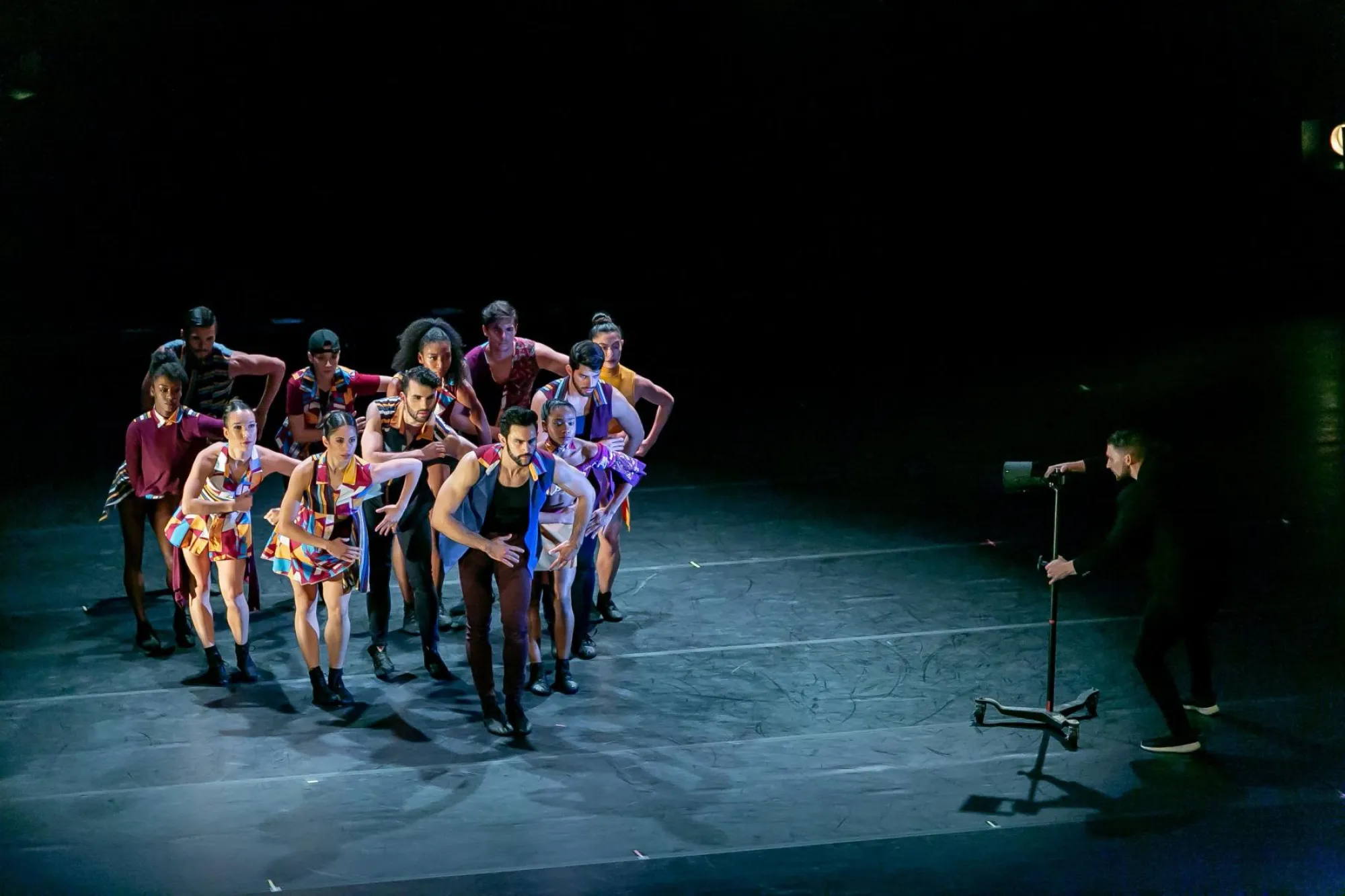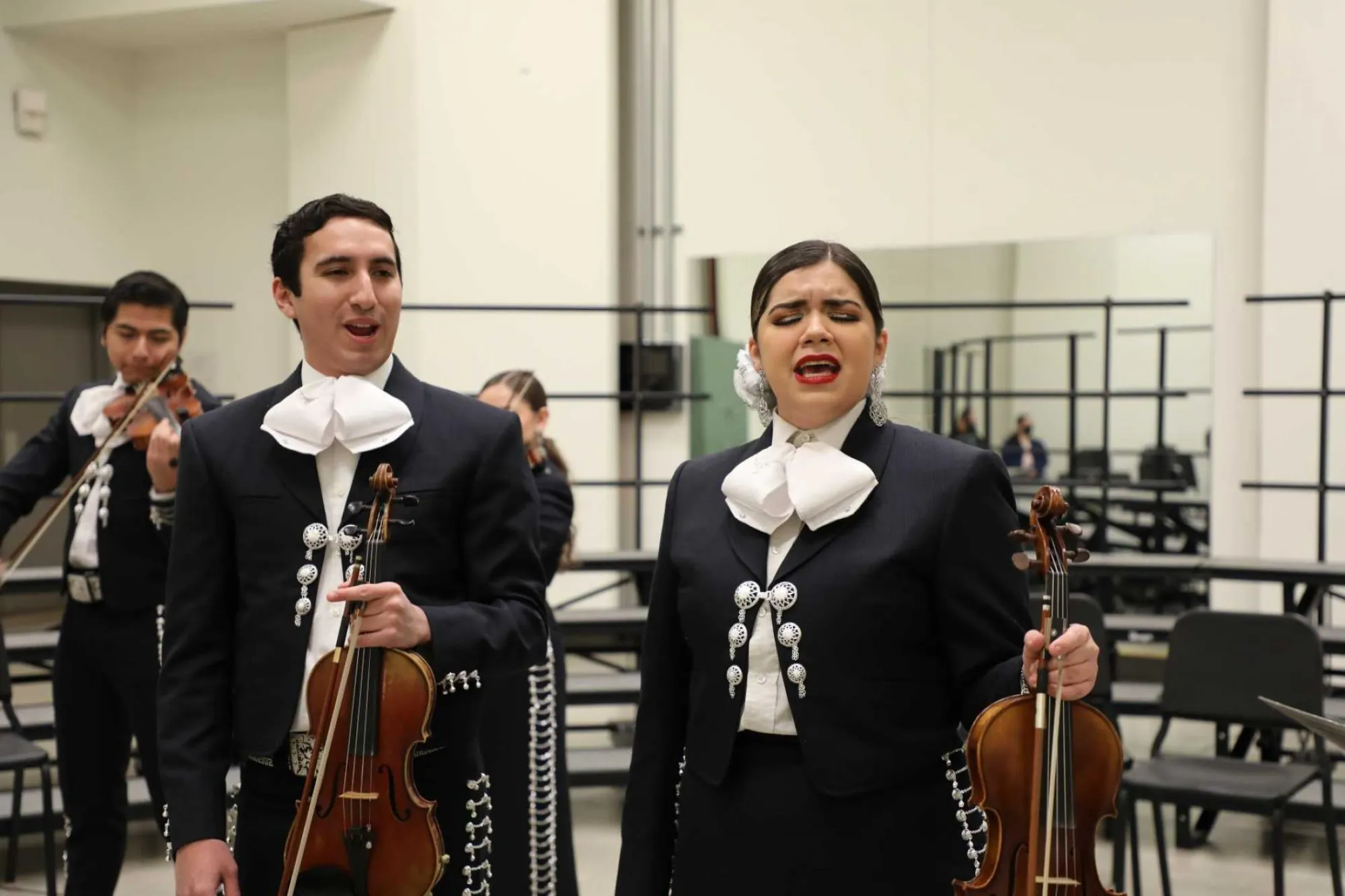Latinx Voices and Work Shine in College’s 2021-22 Season
By Alicia Dietrich and Cami Yates
In 2020, The University of Texas earned the Hispanic Serving Institution designation and was also awarded the prestigious Seal of Excelencia. These recognitions represent a broad effort by the campus and UT community and help demonstrate the university is committed to providing high-quality education that values the Hispanic experience along with other student experiences.
In this issue, we highlight and celebrate some of the amazing performances and visual art from this season that showcase voices and stories of Latinx artists, playwrights, actors, dancers, choreographers, composers and musicians.
Jump ahead to vignettes about
- Ballet Hispánico
- Sonnets for an Old Century
- Mariachi Paredes
- Cositas
- Gabriela Lena Frank
- Tiny Fingerprints
- Blessings of the Mystery

Ballet Hispánico returns to Bass Concert Hall for its 50th season tour
For its 50th anniversary season, Ballet Hispánico returned to Bass Concert Hall to kick off Texas Performing Arts’ own 40th anniversary season during the fall. The show highlighted three works, including Arabesque, a work originally choreographed by Vicente Nebrada in 1984 at a time when few Hispanic choreographers had a platform for their work. Fusing classical ballet with flamenco movements, Arabesque is set to Spanish composer Enrique Granados’ Twelve Spanish Dances and exemplifies the company’s aesthetic during the 1970s.
The performance also included two contemporary pieces: Tiburones by Annabelle Lopez Ochoa and 18 + 1 by Gustavo Ramírez Sansano. Tiburones takes a critical look at discrimination and stereotypes of Latinx culture and how the voices of Latinx artists have been diminished in popular culture. The work specifically targets West Side Story, which was recently adapted into a new film version directed by Steven Spielberg and released in December.
Set to Pérez Prado’s mambo music, 18 + 1 marks 19 years in Sansano’s career as a choreographer. The performance uses playful choreography full of humor and joy as the choreographer explores the past, present and coming future.
While in Austin, the company performed for and met with young students at Mendez Middle School and engaged with students in the Department of Theatre and Dance.
— AD

20 years later, Sonnets for an Old Century by Puerto Rican playwright José Rivera still feels timely
The Department of Theatre and Dance kicked off its first in-person performance in 20 months with Sonnets for an Old Century by Puerto Rican playwright José Rivera. Featuring a large cast with a series of monologues, each sonnet reflects on a moment in the person’s life at the moment of that person’s death. The show was written in 2000, but two decades later, director and Assistant Professor Corey Allen reflects on the relevance of themes addressed in the show:
We seem forever locked in a conversation about injustice, rage, equity, police brutality and disasters—both man-made and natural—don’t we? In that way, Sonnets for an Old Century is a kind of time capsule that accomplishes what good art should: It holds a mirror up to nature, reminding us of that which we’d rather forget.
— AD

Mariachi Paredes de la Universidad de Texas connects students to musical traditions of Texas borderlands
UT’s Mariachi Paredes is in high demand these days and can be seen performing across the state, from festivals down in the Rio Grande Valley to recruiting events to the halftime show at Longhorn football games.
Founded in 1977 by a group of graduate students, Mariachi Paredes de Tejastitlán chose its name to honor Dr. Américo Paredes (1916–1999), a UT professor in Mexican American Studies and seminal figure in the study of borderlands history, Mexican American Studies and postmodernist anthropological studies.
Currently led by Assistant Professor of Practice Mónica Fogelquist, the ensemble provides a social, cultural and historically aware space for students, enriching their lives through the study and performance of Mexico’s national music.
“Mariachi Paredes aims to be on par with the musical excellence for which the Butler School of Music is known,” Fogelquist said. “In addition to providing students with an enriching musical experience, the mariachi gives students a space to develop their cultural, linguistic and social skills in a real-world setting. They share their music with those familiar and unfamiliar with the (musical) tradition and captivate all audiences with their heartfelt and authentic performances. I could not be prouder of the students’ work to represent Mexican music in the highest light.”
Mariachi Paredes shares their music by performing on campus, throughout the greater Austin area, and around the state. They have been invited to perform at the largest mariachi festivals in the state including the Mariachi Vargas Extravaganza in San Antonio, UTRGV’s FESTIBA Mariachi Festival in Edinburg and the Charro Day’s Festival and Grand Parade in Brownsville. The ensemble has also been featured in Longhorn football game day festivities and performed with the Longhorn Band during the halftime show.
Thanks to new funding support from the President Jay Hartzell, all students in Mariachi Paredes now receive a $1,000 performance scholarship.
— CY

Cositas celebrates rich cultural history of Los Angeles
Dance Repertory Theatre’s Fall for Dance returned in November with its first performance in front of a live audience since 2020. The show opened with a piece by Associate Professor Joel Valentín-Martínez, who joined the Dance faculty in the fall.
Cositas featured a multiethnic ensemble with a solo male dancer (Josh Martínez) in a red satin dress with a train made up of yards and yards of fabric. Originally choreographed as a solo work for Liz Zastrow, a professional Chicago-based dancer in 2011, Valentín-Martínez said he was responding to the lack of Latinx representation on Hollywood’s red carpet.
As the piece evolved over time, Valentín-Martínez cast Latinx male dancer Javier Marchán-Ramos as the soloist in the red dress, which lent a whole different vibe to the piece and played with ideas around gender, queerness and in some ways challenging machismo in Latinx culture. When he set the piece on El Centro Morelense de las Artes students in Mexico in 2019, he added more ensemble dancers and drew further inspiration from the songs such as “Con Safos” by Ruben and the Jets and “Viva Tirado” by El Chicano. In the UT production, he added “Soleá” from Miles Davis’ Sketches of Spain album. All of these compositions helped explore Los Angeles’ rich history and cultural influences from Indigenous, Spanish, Black, Mexican Pobladores (settlers) and their descendant Chicanos/as. (Erica Gionfriddo, Valentín-Martínez’s co-artistic director for Fall for Dance, said the piece was a “love letter to Los Angeles.”)
When he arrived at UT in the fall, Valentín-Martínez saw the rich diversity of dancers in the department and realized they were the perfect group to perform this piece for Fall for Dance.
“Our Dance program has a significant Latinx and African American population,” he said. “Because Los Angeles was founded by people of Indigenous, African, mestizo and Spanish European descent, I felt that with a multicultural, multiethnic cast, this was a perfect combination to soar with.”
The students’ performance in Fall for Dance opened even more possibilities for the future of Cositas for Valentín-Martínez.
“The experience here in the UT Department of Theatre and Dance has helped me create this wonderful version of this piece, but also it has helped me see that it still has more potential,” he said. “If I can see that through this powerhouse of students, I can’t wait to see it on a professional company.”
— AD

Composer Gabriela Lena Frank works with music students, ensembles in residency
Latin Grammy Award-winner and Grammy-nominated composer and pianist Gabriela Lena Frank visited the Butler School of Music in the fall as an artist-in-residence to work with students and ensembles. She received the school’s 2020-21 Eddie Medora King Award, a $50,000 prize for achieved excellence in original music composition.
Frank, who is partially deaf, spent intensive time with composition students during her virtual residency, attending and coaching rehearsals of her work. The Symphony Orchestra and New Music Ensemble performed her music during her time at the Butler School.
“Gabriela is an established and award-winning composer, but more importantly, someone who has made mentorship and cultivation of emerging artists a central part of her practice,” Butler School of Music Associate Director Ryan Kelly said. “Her artistic voice and life experiences were inspirational and transformative in the brief opportunity our students had to work with her, and we’re grateful that the Eddie Medora King Prize made this opportunity possible.”
— CY

UT New Theatre features Tiny Fingerprints by award-winning M.F.A. candidate Jaymes Sanchez
This spring, the Department of Theatre and Dance’s UT New Theatre season features a work by M.F.A. in playwriting candidate Jaymes Sanchez.
Set at San Antonio’s famous haunted train tracks, Tiny Fingerprints explores grief, the nature and power of belief and the lies we tell ourselves to make life worth living. In the play, Bobby believes that the spirit of his dead child lives with the “ghost children” at the haunted train tracks. As Bobby falls deeper into grief and delusion, his ex-wife urges him to seek help, a famous psychic medium encourages his fantasies, and a YouTube science personality attempts to destroy his world with reason. As mischievous ghost children and a troubled playwright meddle in the action, Bobby’s fantasies become the foundation of his life, and the destructive potential of the truth grows.
Sanchez won the prestigious Keene Prize for Literature from the UT College of Liberal Arts in 2020 for his script The Cucuy Will Find You, a play that incorporates Mexican American folklore to address the tensions between traditional and individual identity faced by Latinx millennials. The Keene Prize, awarded to an undergraduate or graduate student every year, earned Sanchez $50,000 for his creation of a work that exemplified the future of American literature and, as E.L. Keene said when establishing this prize, provided a “vital portrayal of the American experience in microcosm.”
— AD

Blessings of the Mystery debuts at Visual Arts Center before traveling nationally
During the fall, Carolina Caycedo and David de Rozas’ exhibition The Blessings of the Mystery debuted at the Visual Arts Center and examined themes of environmental activism, encounters between history and memory, Indigenous rights and the formation and dissemination of knowledge.
With a focus on West Texas, the exhibition centered around troubled histories of colonization and migration, explored through sculpture, collage, installation, drawing and film. The exhibition’s centerpiece was Caycedo and de Rozas’ The Teaching of the Hands, a single-channel film that recounts West Texas histories from the perspective of Juan Mancias, chairman of the Carrizo/Comecrudo tribe of Texas.
“All the rivers run with the blood of my people,” Mancias said in the film. “And their tears, in Texas.”
The film combined experimental and observational documentary with oral stories and documents, as well as reenactments and archival footage, weaving together scenes from 4,000 years in the past to the present day.
The exhibition also featured a site-responsive installation composed of surveying tools and artifacts used to create parcels of land in Texas. Suspended from the Visual Arts Center’s vaulted ceiling using cables and wires, Measuring the Immeasurable uses floating items that reference the history of the region’s landscape and its rapid privatization, a process that displaced many people and animals and reshaped Texas.
Alongside other original artworks by Caycedo and de Rozas were a selection of objects pulled from UT’s Biodiversity Collections and the Billie L. Turner Plant Resources Center documenting physical changes to the landscape, flora and fauna. Original watercolors produced in the 1930s by artists Forrest and Lula Kirkland detail the ancient rock art of the Lower Pecos River that was destroyed by flooding, erosion or human interaction.
The exhibition will now travel to The Rubin Center at The University of Texas at El Paso, Ballroom Marfa and New York’s Museum of Modern Art.
— CY

